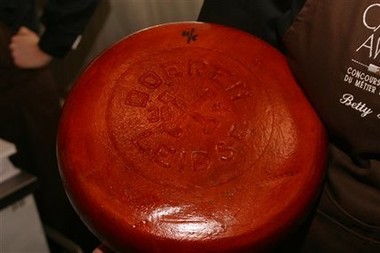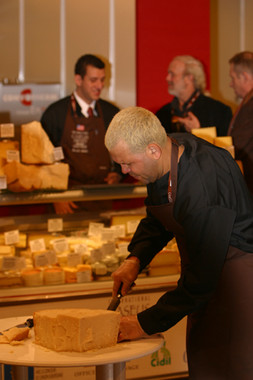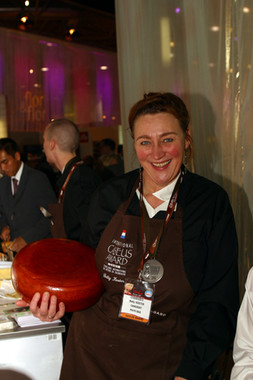Who disapproved of my cheese?
January 30, 2007 - Associated Press

LYON, France
The scoreboard gives the impression that Team USA, in its first foray into the cheese competition here, got its butt kicked.
Hard.
Twelve countries entered. The Americans came in 12th.
To rub a little salt into the rind, the winner was the heavily favored home team: France.
However, not only is this an unhealthy way to look at International Caseus Award’s cheese event, it’s also missing the point.
From the outside, the biennial contest looks like some sort of Super Bowl of cheese, right down to the media swarm and the several hundred spectators who attend the day-long event. But Caseus is more like a powwow for elite cheesemongers, the professionals who are dedicated to getting the world’s best cheeses into our mouths.
Representing the United States were Franck Meilak and Cielo Peralta of New York’s famous Murray’s Cheese Shop. Neither is a cheese rookie. Meilak, 38, has worked at Murray’s since he was 16; Peralta is the shop’s biggest personality, simply known as “Uncle Cheese” to many of his customers.
“We work with everybody here,” said Meilak, gazing at the competition and reflecting on why they crossed an ocean to compete, “and it’s good to show the world that the United States is up-and-coming.”
PARMESAN NINJA
Arriving less than 24 hours earlier, Team USA looked shell-shocked from jet lag. Nevertheless, they threw themselves into the competition which was divided into events, such as a sales-pitch test, a blind tasting and—don’t laugh—cheese cutting ability.
While Meilak was backstage taking a multiple choice exam, Peralta prepared for the cheese cutting by stroking a giant wheel of Parmigiano Reggiano, then making menacing kung-fu chops in the air around it.
 Team USA cheesemonger Cielo Peralta makes quick work of a Parmigiano-Reggiano wheel.(AP Photo/Joe Ray)
Team USA cheesemonger Cielo Peralta makes quick work of a Parmigiano-Reggiano wheel.(AP Photo/Joe Ray)“Am I nervous?” he asked, if rhetorically, just before attacking the wheel with a mean set of specialized Parm-cutting knives.
“I’ve been doing this for 13 years,” he said. “I deal with the product every day.”
While competitors from the 11 other countries took almost all of the 30 minutes allotted to cut the wheel into smaller sections of different sizes, Peralta diced his up with a grunting fury that sent shards of Parm flying into the air, finishing the job in about half that time.
“I’ve never seen anyone cut Parm so fast,” said competition judge and cheese-maker Jacques Bernat, with a look of perplexity and amazement.
“There was a violence to it,” marveled a U.K. cheese insider, “but it was done with utter commitment.”
Compared to other competitors’ relatively stony-faced styles, Peralta’s would have screamed “American moron” if he weren’t such an expert. Instead, his efforts landed him squarely in the middle of the very respectable pack for the trial.
“Caseus lets people here (in France) figure out that there are other cheesemongers out there and they teach us the customs of their country,” said event judge Father Gabriel, who is also head of an orthodox monastery where they produce a fine goat’s-milk cheese called Saint Nicolas de la Dalmerie. Events like this, he adds, “help the French break out of their stagnation.”
 Cheesemonger and Betty Koster holds up a wheel of her favorite Dutch cheese, Boeren Leidse (Farmer’s Leyden). (AP Photo/Joe Ray)
Cheesemonger and Betty Koster holds up a wheel of her favorite Dutch cheese, Boeren Leidse (Farmer’s Leyden). (AP Photo/Joe Ray)EXCHANGE STUDENTS
Not only does Caseus give its contestants a chance to see where they stand in the world, they also learn a lot.
The French, for example, were very strong at describing technical elements of cheese (that comes from centuries of being the fromage capital of the world). But cheese sellers everywhere could learn from England and Ireland’s convivial, put-the-cheese-in-the-customer’s-mouth style, for instance.
Relative to most other competitors’ home countries, the United States has little cheese flowing through its veins (so long as Velveeta, powdered cheddar and all propelled-out-of-a-can varieties are excluded). American cheesemongers worth their salt cater to a crowd that tends to have more enthusiasm than savvy, and using that approach at Caseus didn’t always go over well with the judges: Peralta presented a French cheese to the panel like he would to Greenwich Village tourists—and got crushed in the scoring.
“The U.S. is the rookie team playing in the majors today, but now we know what we’ll do for the next competition,” said Meilak. “Give us a few more years and we’ll be able to do a pretty good job.”
“All over the U.S., everybody is my friend,” said Peralta, summing up his love for his customers at Murray’s.
After last week’s competition, it looks like Uncle Cheese has gone global.
CHEESE COURSE
Many cheesemongers came to the Caseus Awards with their favorite local cheeses a sampling of some of the best:
Westcombe Cheddar
An unpasteurized cow’s milk cheddar from the UK in a traditional cloth rind. “It’s a return to traditional cheesemaking that’s coming to typify English cheese,” said Jane Hastings of Neal’s Yard Dairy cheese shops in London.
Wabisuke
Team Japan (which took fourth in the competition) came with a secret weapon—a traditional French goat’s milk cheese Sainte-Maure de Touraine soaked in sake. The famous alcohol gives the cheese a curiously sweet and long-lasting flavor. My tasting notes read: “That’s freaking good!”
Herrgård
The list may be tiny, but this is one of Sweden’s best-known cheeses. Often compared to a French Comté, the semi-soft cow’s milk cheese has a slightly nutty taste and smell.
Monnoir
An artisan Canadian from special cows, whose rich milk gives the cheese a beautiful aftertaste that lasts several minutes.
Boeren Leidse (Farmer’s Leyden)
Cheesemonger Betty Koster brought this aged cow’s milk cheese loaded with caraway and/or cumin seeds from Holland. “It dates back to the days of spice trading, thanks to its low fat content that allows it to travel well,” she said.
asap contributor Joe Ray is a freelance food and travel journalist based in Paris. He can be reached via his Web site, www.joe-ray.com.